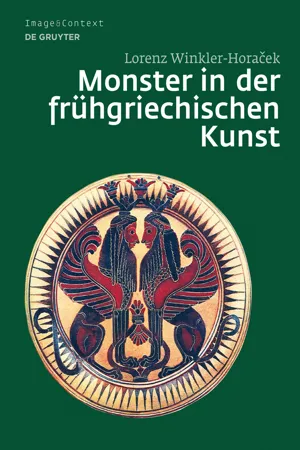
Monster in der frühgriechischen Kunst
Die Überwindung des Unfassbaren
- 704 pages
- English
- ePUB (mobile friendly)
- Available on iOS & Android
About this book
Bildfriese mit aneinander gereihten Monstern und Wildtieren sind ein Leitmotiv in der frühen Bilderwelt der Griechen (etwa 700 bis 550 v. Chr.). In dem Buch geht es um die Aneignung der Monster-Ikonographie aus dem Orient sowie ihre spezifische Ausformung in der damals führenden Luxuskeramik von Korinth. Lorenz Winkler-Hora?ek entdeckt das von den Vasenmalern entwickelte Regelsystem, nach dem die Monster und Wildtiere geordnet sind. Damit eröffnet er eine neue anthropologisch-historische Perspektive: die Monster symbolisieren das Unheimliche der Wildnis jenseits der griechischen Zivilisation. Mit der Rationalisierung des Unfassbaren entwickelte Korinth eine Ikonographie, die in der Phase der Konsolidierung der griechischen Polis und in Zeiten der Kolonisation Maßstäbe setzte.
Frequently asked questions
- Essential is ideal for learners and professionals who enjoy exploring a wide range of subjects. Access the Essential Library with 800,000+ trusted titles and best-sellers across business, personal growth, and the humanities. Includes unlimited reading time and Standard Read Aloud voice.
- Complete: Perfect for advanced learners and researchers needing full, unrestricted access. Unlock 1.4M+ books across hundreds of subjects, including academic and specialized titles. The Complete Plan also includes advanced features like Premium Read Aloud and Research Assistant.
Please note we cannot support devices running on iOS 13 and Android 7 or earlier. Learn more about using the app.
Information

Anmerkungen
Einleitung
| 1 | www.faz.net/aktuell/politik/gentechnik-patentamt-weist-einspruch-gegen-misch wesen-zurueck-129921-b1.html. |
| 2 | www.sueddeutsche.de/wissen/mensch-rind-mischwesen-das-abstumpfungsexperiment-1.232728. Der Artikel beruhigt den Leser: „Ein Mensch mit einem Rinderschädel wird nicht entstehen – und auch keine Kuh mit einem Menschenkopf. Die geplanten Experimente britischer Forscher werden keine neuen Fabelwesen hervorbringen, wie sie seit jeher aus Mythen und neuerdings auch aus den Laboren mancher Biotechnologen bekannt sind. Die Wissenschaftler wollen ‚lediglich‘ Stammzellen für die Forschung züchten und sich dazu verschiedener tierischer Keimzellen bedienen – und englische Behörden erlauben es ihnen.“ |
| 3 | www.ethikrat.org/publikationen/stellungnahmen/mensch-tier-mischwesen-inder-forschung. |
| 4 | Ebenda S. 10. |
| 5 | Padgett (2003a). |
| 6 | Tori – Steinbrecher 2012; Marzatico – Tori – Steinbrecher (2013). |
| 7 | Paris – Setari – Giustozzi (2013). |
| 8 | Vgl. das Symposion Mensch und Tier in der Antike. Grenzziehung und Grenzüberschreitung 2005 an der Universität Rostock (Alexandridis – Wild – Winkler-Hora- ček [2008]. S. bes. die Einleitung ebenda 1–7) oder die Tagung Sacred Animals and Monsters in Greek and Near-Eastern Religions im Januar 2014 an der School of Classics der University of St. Andrews (www.st-andrews.ac.uk/classics/events/ conferences/animals/). Vgl. auch jüngst Baglioni (2013), dessen Beiträge hier nicht mehr berücksichtigt werden konnten. |
| 9 | Vgl. Dehl-von Kaenel (1995) 29 mit Anm. 84. |
| 10 | Vgl. Bhabha (2012). |
| 11 | Vgl. http://de.wikipedia.org/wiki/Monster (Eintrag vom 3. April 2013). |
| 12 | Monster, USA 2003 mit Charlize Theron. |
| 13 | Borgards – Holm – Oesterle (2009). |
| 14 | Borgards – Holm – Oesterle (2009) 9. |
| 15 | Borgards – Holm – Oesterle (2009) 9. |
| 16 | Vgl. zur ‚Figur des Dritten‘ das 2009 ausgelaufene Graduiertenkolleg der Universität Konstanz: www.uni-konstanz.de/figur3/; Eßlinger et alii (2010). |
| 17 | Cohen (1996) 6. |
| 18 | Alexandridis (2009); Alexandridis (2013); dieselbe, „Zῷα: Bilder des Körpers zwischen Mensch und Tier im Mythos von Aktaion“, in: Alan Shapiro – Frank Waschek (Hg.), Fluide Körper – Bodies in Transition, Paderborn (im Druck). |
| 19 | Borgards – Holm – Oesterle (2009) 9. |
| 20 | Ebenda 10. |
| 21 | Atherton (2002) S. X; vgl. auch Gilmore (2003) 5 in Anlehnung an Mode (1973) 12. |
| 22 | Vgl. Karl Ernst Georges, Ausführliches Lateinisch-Deutsches Handwörterbuch8 (Leipzig 1918) II 998 f. |
| 23 | Atherton (2002) S. XXIVf. |
| 24 | Zu den Kentauren s.u. 375f. Vgl. Hölscher (1998 a) 61–63; Padgett (2003b) 5–27. |
| 25 | Clare (2002) bes. 5. |
| 26 | Homer, Odyssee 1, 70f. |
| 27 | Homer, Odyssee 9, 292. |
| 28 | Clare (2002) 17. |
| 29 | Aston (2011); vgl. auch Aston (2008). |
| 30 | Aston (2011) 43. |
| 31 | Aston (2011) 94. |
| 32 | Tsiafakis (2003) 73. |
| 33 | Homer, Ilias 5, 741 (Gorgoneion); Homer, Odyssee 9, 428 (Polyphem); 12, 87 (Skylla); 18, 410 (Hephaistos); Hesiod, Theogonia 159. 173. 479. 505. 731. 821 (Gaia); 295 (Echidna). |
| 34 | Vgl. Wilhelm Gemoll, Griechisch-Deutsches Schul- und Handwörterbuch9 (München/ Wien 1954) 589. |
| 35 | Aston (2011) 34; vgl. zu dieser Diskussion auch LIMC Supplementum (2009) 339–359 s. v. Monstra (N. Icard-Gianolio – A.-V. Szabados). |
| 36 | Die Mythenbilder werden zur Zeit von Tonio Hölscher in einer Publikation mit dem Titel Mythen und Bilder in der griechischen Frühzeit bearbeitet. |
| 37 | Thomsen (2011). |
| 38 | Müller (1978). |
| 39 | Vgl. Hölscher (1980). |
| 40 | Bosana-Kourou (1979); Dierichs (1981); Hofstetter (1990). |
| 41 | Demisch (1977); Rösch von der Heyde (1999); Renger (2013). |
| 42 | Petit (2006); Petit (2011); vgl. zuletzt Petit (2013). |
| 43 | Petit (2011) 54. |
| 44 | Petit (2011) 196. |
| 45 | Vgl. dazu auch Childs (2003) |
| 46 | Vgl. hierzu nur exemplarisch: Matthäus (1993); West (1997); Rolle – Schmidt (1998); Matthäus (2000); Burkert (2003); Ägypten – Griechenland ... |
Table of contents
- Cover
- Title
- Impressum
- Dedication
- Vorwort
- Inhalt
- Einleitung
- I oder Dämon: Eine Begriffsbestimmung
- II. Monster ohne Mythen: Die Bilder
- III. Archaische Tierfriese: Syntax und Verhältnis zur ‚realen‘ Welt
- IV Tierwelt – Adel – Polis
- V Fiktionale Grenzräume im frühen Griechenland
- Anmerkungen
- Anhänge I-III
- Zusammenfassung/English Summary
- Literaturverzeichnis
- Index
- Abbildungsnachweise